Best Electric Drill — Buyers Guide, Top Picks, and Comparison
Best Electric Drill Categories
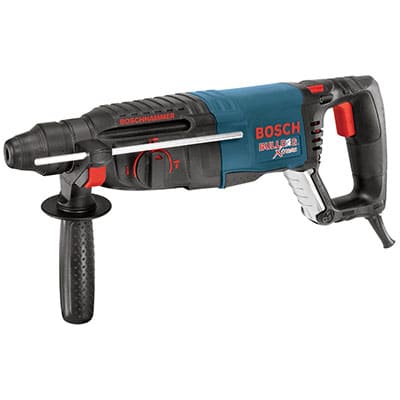
Rotary Hammer Powerful Corded Drill
Providing the maximum level of brawn in the entire drilling category — the best corded power drill units with rotary function are the masters of dense material boring and masonry demolition. Featuring SDS+ compatible chucks, these units are as suited to the hardcore DIYer as the trade pro. With high impact rates, a variety of drilling and hammer action settings, and twin handles — these high amperage machines are crucial for home renovation, construction, and tearing down concretes.
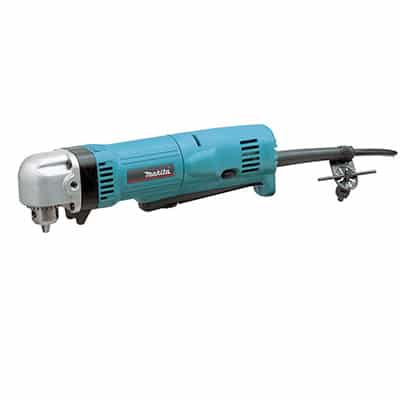
Right Angle Compact Electric Drill
An electric right angle drill opens up a whole new world of drilling possibilities. Its compact build combined with a 90-degree snub head provides effortless access to confined spaces, such as inside cupboards, under sinks, and between floor joists. Mains-powered, it offers consistent and brawny power — and typically boasting either one or two-handed operation, you can adjust your driving style to suit your project’s demands.
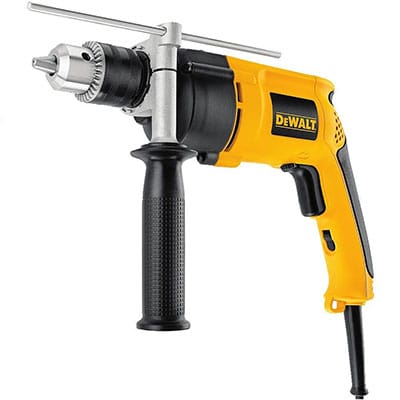
Electric Hammer Corded Drill
Offering powerful pounding, the best corded drill units with hammer function effortlessly bore into dense masonry, concrete, and brickwork. With high impact rates — typically in excess of 46000 bpm — these grunty tools cope with mediums too tough for a standard machine. Often boasting anti-vibration tech, they cut back on user fatigue and deliver consistent, unwavering power. And, with the ability to turn off the hammer feature, they can be utilized as a traditional rotary drill — making them versatile all-around DIY tools.
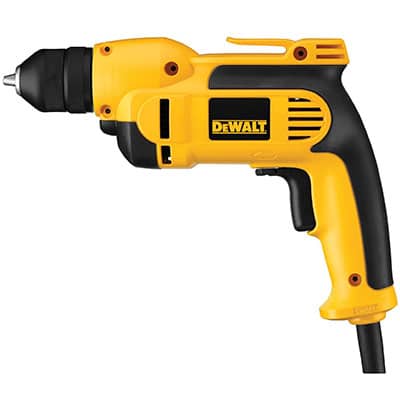
Electric Corded Drill Driver
With the twin capabilities of hole boring and screwdriving, corded drill driver machines are versatile DIY home-improvement tools and light-contractor units. Driven by a mains lead, they offer greater grunt and speed than their cordless cousins — without the headaches of recharging or power loss. And, compatible with a multitude of head accessories, they can be used as rust removers, polishers, grinders, and sanders.
Corded Drill Top Picks
| IMAGE | PRODUCT | DETAILS | ||
|---|---|---|---|---|
|
Best Rotary Hammer Electric Powered Drill 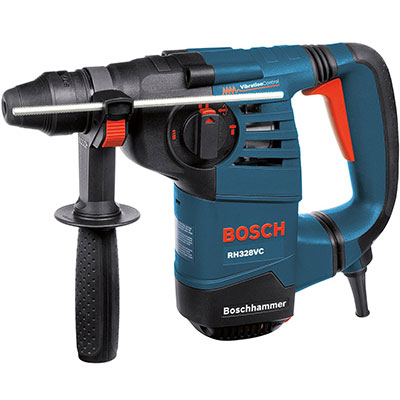
|
Best Rotary Hammer Electric Powered Drill
|
Bosch RH328VC
|
Features
|
Check Price at Amazon Review Bosch RH328VC Review Bosch RH328VC Review |
|
Best Right Angle Drill Electric Hand Drill 
|
Best Right Angle Drill Electric Hand Drill
|
Makita DA3010F
|
Features
|
Check Price at Amazon Makita DA3010F Review Makita DA3010F Review |
|
Best Electric Hammer Corded Hand Drill 
|
Best Electric Hammer Corded Hand Drill
|
DeWalt DW511
|
Features
|
Check Price at Amazon DeWalt DW511 Review DeWalt DW511 Review |
|
Best Corded Drill Driver 
|
Best Corded Drill Driver
|
DeWalt DWD112
|
Features
|
Check Price at Amazon DeWalt DWD112 Review DeWalt DWD112 Review |
Finding the Best Electric Drill – Buyer’s Guide
Affordable, delivering consistent power, and operational straight-outta-the-box — the electric drill category covers a multitude of model options.
Straightforward to maintain, a wide availability of spare parts, and fuelled by 120-volts of electrical energy — the line-up includes a tool for every drilling application.
Incorporating hammer machines, drill drivers rotary units, and right-angle drivers — you can drive into timbers, plastics, masonry, and metal — and even demolish walls.
Electric Corded Drills By Type
Rotary Hammer Electric Drills
A truly heavy duty corded drill format — and the machines that offer the ultimate in brawn across the entire electric category.
These grunty Goliaths are admittedly low on speed, but that’s because they’ve been geared down to deliver phenomenal power. Utilizing a twin-piston system, rotary units create an internal air pocket to both drive the bit and act as a protective cushion — giving rise to their alternative name, electro-pneumatic drills.
This novel power system gives them greater punch-per-pound than their standard hammer drill counterparts, permitting the tools to not only drive into dense concrete, masonry, and brickwork — but also to act as pure demolishing machines.
Featuring contractor-grade SDS+ chucks, they typically boast three drill settings — rotation only, rotation with hammer, and hammer/demolition only. Two-handed operation allows you to provide additional pushing power, while also enabling you to tame these brawny beasts.
However, bear in mind that while they’re the epitome of a high torque corded drill, they’re massive overkill for many DIY applications. While excellent for brickwork and concretes, they’re awful for more delicate materials such as metals, plastics, and timber. Furthermore, if you find the idea of a corded model restrictive — there are cordless models also available.
Rotary Hammer Electric Drills Are Good For:
- Driving holes in masonry.
- Repairing/removing damaged concrete.
- Creating anchor points in footings.
- Chipping render from brickwork.
- Pinning cement wall forms.
- Channeling concrete.
- Creating fixings for stanchions.
- Attaching outdoor HVAC units.
- Securing rainwater goods to building exteriors.
- Demolition.
Rotary Hammer Electric Drills Are Not Suitable For:
- Casual DIY projects.
- Craftwork.
- Cabinet making.
- Fence erection.
- Decking laying.
- Precise projects.
- The faint-hearted.
- Children.
Right Angle Electric Drills
A relatively small corded power drill that offers practicality combined with portability.
The name refers to the chuck head of the unit — unlike standard drills where this crucial component is in line with the casing of the tool, with a right angle machine, it’s positioned at 90-degrees to the body. This allows you to access confined spaces for drilling and driving — the primary function of these machines.
Furthermore, the chuck itself is a snub variety — meaning it can squeeze into areas just two inches wide. Additionally, they boast slimline bodies — appearing quite similar to an electric screwdriver — again increasing their suitability to close-quarter work.
One of the stand-out features of these electric tools — sometimes referred to as 90-degree drills — is that they all share a common large paddle throttle. Unlike traditional drills that have a single or dual finger trigger, these substantial switches permit anything from single to four-digit operation. Meaning, however you wield the drill, even at unnatural angles, you can still control the output speed.
As a relatively small electric hand drill, these tools often double up as a convenient, portable home machine for modest household DIY projects — able to fit effortlessly into kitchen drawers or cupboards.
While this electric drill format is impressively versatile — as suitable for working between floor joists as it is in car engine bays — the models lack the grunt for hardcore applications. Try to use them with a base material denser than timber, and they will struggle.
Furthermore, although they can access the places other electric drills cannot reach — you’re still hampered by a mains lead. That said, there are cordless right-angle machines available that ditch power outlet tethering.
Right Angle Electric Drills Are Good For:
- Working between decking joists.
- Automotive engine bay applications.
- Plumbing beneath bathtubs and sinks.
- Driving betwixt ceiling slats.
- Preventing knocked knuckles.
- One of the best corded drill for woodworking.
- Compatible with grinding, polishing, and buffing accessories.
- Creating channeling in timber.
- Cabinet construction.
- Working inside cupboards.
- Fixing drywall studs.
- Jobs that require one-handed operation.
- Use as a compact household general application tool.
Right Angle Electric Drills Are Not Suitable For:
- Demolition.
- Drilling into concrete, brickwork, or masonry.
- Large bits.
- Use as a mixing tool.
- Jobs that demand two-handed use.
Electric Hammer Drills
Delivering a powerful pounding action in addition to standard rotational boring — corded hammer drills are excellent tools for driving into dense materials such as brickwork, blockwork, and masonry.
Offering more grunt and speed than their cordless counterparts — they typically deliver over 2700 rpm and 44000 bpm (blows per minute). Furthermore, usually being half inch electric drill machines, they can accommodate wide diameter bits in addition to mixing accessories.
The ability of hammer drills to make light work of dense construction materials makes them excellent tools for attaching rainwater goods, hanging satellite TV dishes, and securing HVAC units.
And, while they may be an ideal hardcore medium borer — you can still use these machines with precision and accuracy. Virtually all models permit you to turn off the hammer mode — allowing you to use the drill for soft plastics, metals, and timbers. It’s this application versatility that makes hammer machines the ideal all-around DIY tool.
That said, they aren’t suitable for screw driving — even on the lowest power setting, they’re liable to shear screwheads. For those project types, you need a drill driver. Furthermore, they lack the eye-watering grunt of rotary hammer drills — which, unlike standard hammer machines, are capable of demolition work.
Electric Hammer Drills Are Good For:
- Driving into dense brickwork and concrete.
- Use a timber, plastic, and metal borer.
- Utilizing wide diameter bits.
- Use with plaster and paint mixing accessories.
- Tackling dense hardwoods.
- Creating channels for pipes and wiring.
- Use as a versatile DIY drill.
Electric Hammer Drills Are Not Suitable For:
- Hardcore demolition projects.
- Driving screws and bolts.
- Confined space applications.
Electric Drill Drivers
Possibly the most affordable and versatile tool for DIY home-improvers. With straightforward function and suitable for newbies, they’re traditionally what people refer to when they talk about corded drills.
Their name comes from the two main purposes of these units — driving and drilling.
For making holes, these machines typically feature either a 0.5-inch or 0.375-inch chuck — making them compatible with the majority of wood, acrylic, plastic, and sheet metal bits. With speeds around 1000 rpm or above, they’re suited to time-intensive and repetitive drilling work.
In the case of driving projects, they boast adjustable speed and torque, and a pressure-sensitive clutch — easing off the grunt when meeting user-defined resistance. This enables them to effortlessly tighten bolts and drive screws (with the correct bit) without damaging the screw head.
Additionally, most corded driver drills can be utilized with Dremel-esque accessories — for example, mini-grinders, rust removers, brushes, points, polishers, and honers. Thus making them highly appealing to the all-around DIYer.
However, their market share is small — being towered over by the mighty cordless drill drivers. Offering greater operational freedom than their corded compatriots, they’ve rapidly become the go-to choice in dual-function drills.
That said, electric corded driver drills do have advantages over their more common battery-driven cousins — they’re typically lighter on the wallet, permit continuous operation with no recharging requirements, and usually offer higher speed and torque.
The main limitation of mains-powered drill/drivers is that they lack the durability and brawn for masonry — for these jobs, you need a hammer or rotary tool.
Electric Corded Drill Drivers Are Good For:
- General home improvements.
- Boring into timber, sheet metal, and plastic.
- Use as a brawny electric nut/screwdriver.
- Finishing applications — with a suitable attachment.
- Cabinet building.
- Craftwork.
- Price to quality ratio.
Corded Electric Drill/Drivers Are Not Suitable For:
- Working in confined spaces.
- Projects away from a power source.
- High-level jobs.
- Attacking brickwork and cement.
- Demolition projects.
Considerations When Purchasing the Best Corded Drill for Sale
As outlined in this article, the electric corded category covers a vast spectrum of drill formats — each boasting its own characteristics and applications.
Hence, when looking for your consummate boring machine, I recommend checking out my detailed and specific buying guides for each type — rotary hammer drills, right-angle drills, drill drivers and hammer drills.
However, for a generalized overview, here are the main considerations I feel you should take into account when exploring the corded drilling arena:
Electric Power Drill Type
Undoubtedly, the most crucial consideration.
As explained above, there are four key electric drill formats — each with its own suitability to different projects.
For detailed advice, check out my thorough guides to the rotary, hammer, drill driver and right-angle models. But for a swift outline, use the tools as follows:
- Rotary hammer — for hardcore masonry and demolition.
- Hammer — for driving into concrete and as a general DIY drill.
- Right-angle — for confined and close-quarter drilling.
- Drill driver — for screw driving and low-intensity drilling.
Electric Drill Motor Type
Electric mains-driven drills incorporate one of two motor formats — brushed or brushless.
The brushed motor — no shock here — features an internal engine that utilizes brushes to create contact with the motor itself. A brushless corded drill, however, boasts a complex system of electro and permanent magnets to rotate the rotor.
My advice is this — if possible, opt for the brushless variety.
With no direct contact between the internal components, heat and friction energy losses are impressively minimized — making the tool more efficient. Admittedly, this isn’t such a crucial concern with corded machines as it is for cordless — where power wastage leads to a rapidly draining battery.
However, even with mains-powered machines, you receive the benefits of lower (slightly) electricity bills and the advantage of greater speed and torque than a brushed drill — with the same wattage motor.
Generally speaking, a budget or cheap corded drill will have a brushed motor, while the premium-grade tools will boast a brushless powerhouse.
Power Cord
Unlike cordless drills, the electric models naturally require the use of a mains lead to deliver the power.
When selecting your ideal tool, I suggest checking out the length of the electricity cord — the longer the cable, the further away from a power outlet you can operate. That said, it’s unusual to find a machine with a mains lead longer than eight feet.
Hence, in many — if not the majority — of projects, you will need an extension cable. Always ensure that this lead is sufficiently rated to use with the amperage of your particular drill.
Cord Protector
Advancements in technology have made corded electric drills inherently reliable. Robust and durable, they can withstand a surprising amount of abuse, especially the premium-grade units.
However, one component remains highly susceptible to damage — the cord. It’s not so much accidental snagging or cutting that’s the issue — it’s everyday wear and tear.
In the majority of electric models, the cable is attached to the main body at the handle foot. The more you move the drill, the more stress you place on the tethered cable. This constant motion wears away at the plastic wire sheathing, and places pulling stress on internal electrical connections.
Therefore, always look for a drill with a substantial cord protector. This adds additional stability to the wire connections, and shields against abrasions.
Chuck Size and Format
Electrical drills generally have either a 0.375-inch, 0.5-inch, or SDS+ chuck — affecting the type of bit you can utilize with the machine.
The 0.375-inch format is suitable for most timber, plastic, metal, and masonry-specific bits — and the ideal size for the general DIYer.
Moving up to the 0.5-inch size allows you to utilize larger diameter bits — suitable for projects, such as creating channeling for pipework or cables.
The SDS+ format is the domain of the rotary drill — a system that allows the bit to move along the vertical plane to ensure maximum crushing power.
Additional Accessories
It doesn’t matter whether you’re seeking the consummate DIY tool or a premium-grade contractor drill — investigating what accessories arrive with your machine can insure against buying additional products, provide an affordable drill purchase, and prevent disappointment when you open the box.
Trust me, there’s nothing worse than eagerly wrapping your new unit — only to discover it doesn’t include everything you need to crack on with your drilling.
Hence, when researching your electric corded drill, look out for (depending on the format):
- Storage case.
- Interchangeable chucks.
- Drill bits.
- Chuck key (if not keyless).
- Lubricant.
- Tool wrench.
- Lengthy warranty.
- Depth gauge.
Conclusion
Mains-driven drills offer consistent and unwavering power — allowing you to crack on with your boring, demolition, or driving project without worrying about the battery life or cell recharging.
Available in rotary, hammer, drill driver and right-angle formats, there’s a tool for every DIY or trade application — whether you’re demolishing walls, working inside tight engine bays, or addressing dense concrete.
When selecting your ideal unit, consider the accessories included with the product, the chuck size, the length of the cord, and whether it features a brushless or brushed motor.
Sure, they aren’t suitable for all users. Guys who demand additional portability, the advantage of operating away from mains outlets, and the ability to work at high levels without hazardous mains leads should opt for cordless machines instead.
However, if you want the reliability of steady power combined with affordability — I suggest getting hold of a corded electric drill.
Electric Corded Mains-Powered Drills FAQs
Q: What Is the Best Corded Electric Drill for Demolition?
For extreme drill projects such as demolishing or chipping concrete and brickwork — nothing less than a rotary drill will suffice. In my opinion, the ultimate unit is the Bosch RH328VC. It boasts 2.4 ft-pounds of torque, a two-finger trigger operation, and an anti-vibration system.
Q: Who Makes the Best Electric Mains Drill?
When looking for your consummate machine, check out the specialized drill manufacturers that retail units renowned for their reliability, power, and access to spare parts. The leading marques are Bosch, Makita, and DeWalt.
Q: What Is the Best Electric Drill for Concrete?
Standard corded machines are too weedy for dense construction materials such as brickwork and concrete. Instead, you need a hammer drill — such as the mighty DeWalt DW511 that boasts 46000 bpm, an auxiliary handle, and weighs just 4.3 pounds.
Q: How to Choose the Best Electric Power Drill?
When selecting your dream machine, consider:
- Format — rotary, drill driver right-angle, or hammer.
- Brush or brushless motor.
- Length of the power cord.
- Chuck size.
- Whether the machine arrives with accessories.
Q: What Is the Best Corded Electric Drill for Confined Spaces?
If you’re working in tight spaces such as in engine bays, beneath floorboards, or inside cupboards — you need a right-angle drill. For me, the ultimate example is the Makita DA3010F that has an eight-foot power cord, 2400 rpm, and a convenient 0.375-inch chuck.
Q: Can I Use an Electric Drill for Screwdriving?
Yes. Use a corded drill driver that offers user tailorable torque, variable speed, and a pressure-sensitive clutch.
Q: Can a Pneumatic Drill Run Off Electric?
No. As the name implies, a pneumatic drill utilizes air as its power source, not electricity. The closest tool in the corded category are electro-pneumatic drills — also known as rotary hammer drills — that mimic the power and cushioning of true pneumatics via an internal air bubble.
Q: What Is Better Corded Electric Drills Vs Cordless Drills?
This depends on personal preference and the demands of your projects.
Typically, corded models offer higher speeds and torques than battery-operated models — while also promising consistent power without the headaches of running out of juice.
Cordless machines deliver greater portability than electrics, allow you to operate with no access to a mains source, and abandon the sometimes annoying and hazardous power cord.
Q: Do I Need a Compressor for the HomeRight Super Finish Max?
No. The handheld Super Finish Max is powered by an internal turbine, negating the requirement for a compressor. HomeRight has no pneumatic machines in its product range — only turbine HVLP units and airless sprayers.
Q: Can an Electric Hammer Drill Work as Screwdriver?
You can try, but you will wreck your screws. The power output from most hammer drills is too intense for driving work — meaning you will simply shear the head of your bolt or screw. Instead, opt for a specialized drill/driver.
